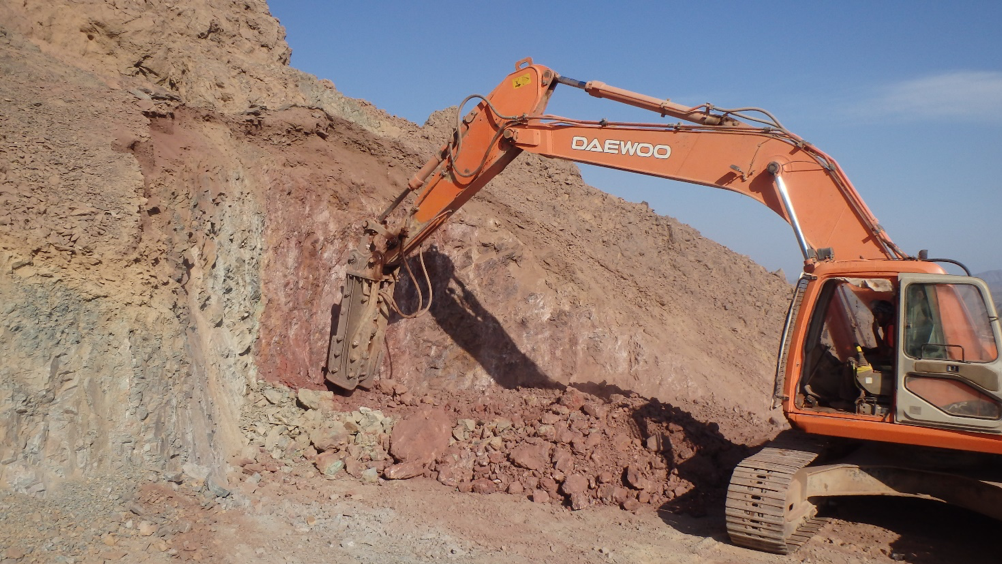Rodruin
GEOLOGY
The rock types at Rodruin are comprised predominantly of a series of typically carbonate altered or dolomitic metasediments, mainly greywackes and slates, and carbonate lithologies. The carbonates display sedimentary textures in places, and it is likely they are largely of sedimentary, and possibly stromatolitic origin. The clastic sediments are possibly of epiclastic or volcaniclastic origin, although there is very little evidence of volcanic activity in the immediate area of the Rodruin South Ridge. An intrusive diorite body outcrops south of Aladdin’s Hill, and massive rhyolites of undetermined origin outcrop to the northwest of Aladdin’s Hill. Rhyolitic lapilli tuffs outcrop on the North Ridge, The sequence is cut by frequently north-south striking andesitic dykes. The sediments and carbonates were apparently deposited in a shallow, quiescent marginal environment.
The Rodruin area is structurally complex with significant faulting and folding present throughout the entire prospect area. There is also strong evidence of low angle thrust faulting at Rodruin. The South Ridge is capped by massive carbonate which appears to be located in the overthrust block, and is strongly mineralized near the summit peak of the ridge. Faulting clearly truncates mineralization in places, and there is strong evidence of mineralization being associated with structures and metal enrichment, notably copper staining immediately along faults. The Spiral Pit underground workings are clearly localized along a fault structure which truncates the gossan-hosted mineralization in channel profile ROC-017, suggesting strong enrichment of gold and other metals along structures.
Due to the steep topography much of the Rodruin area is covered in a thin layer of unconsolidated scree and talus, obscuring the subcrop. A localized mega-breccia has been mapped on the northern flank of the South Ridge, consisting of massive blocks of re-cemented carbonate which has been interpreted as an in situ mass slump or landslip feature, and potentially obscures sub-cropping mineralization.

Much of the gold mineralization at Rodruin appears to be associated with dolomitic carbonate rock types, typically strongly weathered and gossanous at surface. This mineralization occurs over a significant surface area of the South Ridge, and often carries significant zinc values. This style of mineralization takes the form of gold- and zinc-rich dark brown, yellow or reddish brown and almost black gossans. RC drilling has intersected deep primary equivalents of this mineralization in the area northeast of Aladdin’s Hill, indicating likely depth potential. The gossanous carbonate-hosted mineralization is variably precious and base metal-rich, with gold frequently associated with silver, zinc, and in places copper. The mineralization within these carbonate gossans tends to be rich in zinc (>30% in places) but poor in copper and lead relative to the phyllic hosted mineralization at Aladdin’s Hill.
There is strong evidence for there being a separate phase of higher grade structurally controlled mineralization, such as at Aladdin’s Hill, the Spiral Pit, and in quartz-rich structural zones on the North Ridge. The gold mineralization at Aladdin’s Hill is associated with a series of strongly phyllic altered rocks, consisting of granular quartz, mica and iron oxides, presumed to be meta-sediments. Ancient workings have been sampled to a depth of 40m below ground level, returning assays of up to 15.45 g/t Au, and drill hole ROP-003 returned assays from individual 1m samples of 221 g/t Au and 94.3 g/t Au, confirming the existence of very high grade mineralization within this highly altered unit. The mineralization at Aladdin’s Hill consists of native gold, which is typically associated with supergene copper, lead, arsenic and zinc minerals. Underground samples from the Spiral Pit workings have also returned assays of up to 35 g/t Au, and a single sample from ancient workings on the North Ridge returned an assay of 321 g/t Au. Abundant coarse gold has been identified from samples taken at surface at Aladdin’s Hill. The mineralization at the Spiral Pit bears strong similarities to that seen in the high grade underground workings at Aladdin’s Hill.


